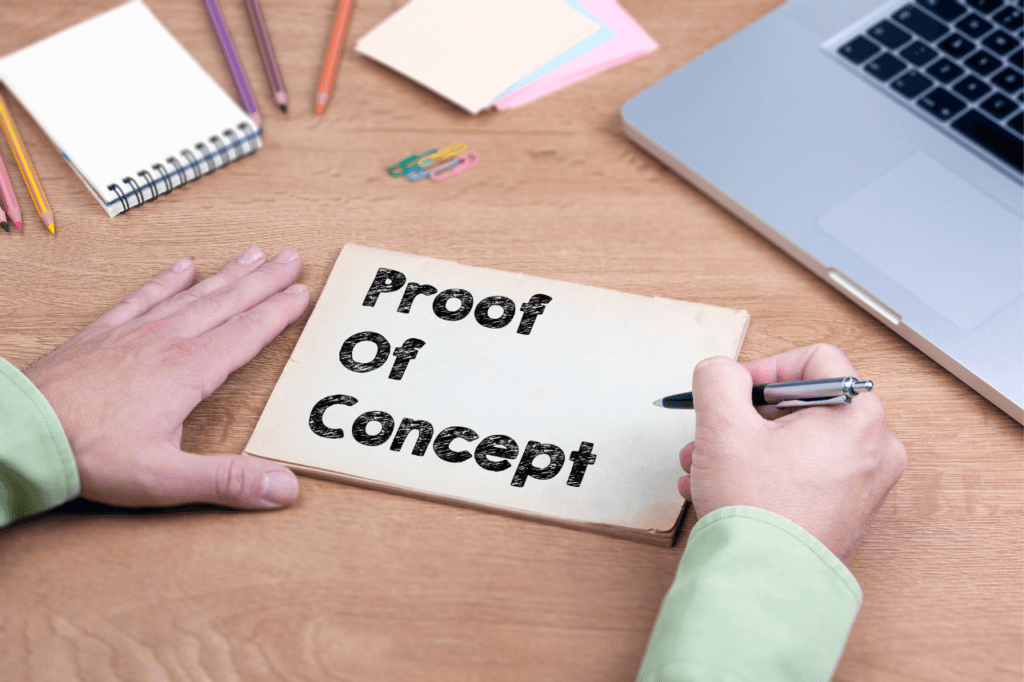Product development projects cannot move forward without proof that a product is viable. That’s why a proof of concept (POC) is necessary to demonstrate that a business idea, product or project has a solid foundation on which to start working.
Regardless of the industry, a proof of concept will help you evaluate whether your concept – be it a product, idea or design – is profitable and has the potential for real-world application.
Throughout the article, we explain what a POC is, its phases and the differences between proof of concept, prototype and minimum viable product.
What is a proof of concept?
The proof of concept, known by its acronym POC (Proof Of Concept), is a fundamental part of the design process. It is an initial test of an idea, method or product in order to show its potential and feasibility in the real world.
The proof of concept takes place during the ideation phase of a project, before the design and engineering work begins, and usually consists of a small and relatively simple or undeveloped version of the final product.
The purpose of a proof of concept is to validate assumptions and illustrate that a new product or idea could be successful. In this sense, product development and team members also use proof of concept as a tangible way to identify any unforeseen risks in the production or execution of the product or idea.
In this way, proof of concept is an excellent method for determining the feasibility of a product concept before launching it.
However, the POC does not demonstrate the shape of the final design; rather, it only represents limited functionalities of the product.
When to implement a proof of concept?
As we say, a proof of concept is key in the launch of a product, methodology or theory. But when to implement it? Normally, it is due to these 2 scenarios:
- A new project: The proof of concept is essential for new projects, new ideas. The POC will serve as a pilot project.
- A new way to improve your current project: When a new function is incorporated, a process is modified… in this case it is also advisable to opt for a proof of concept.
It should be noted that, in order to carry out the proof of concept, it is necessary to conduct market research to determine whether there is already something similar to the new idea you have in mind or to this new way of improving your project.
Phases of a concept test (POC)
To carry out a proof of concept (POC), it is necessary to follow several steps. From the development of the idea to its realization and presentation to investors; we can differentiate up to 5 phases of a proof of concept:
1. Demonstrating the need for the product.
When presenting the proof of concept, the need for the product must be established by mentioning who the target audience is and what are their pain points or situations that customers may encounter.
In this sense, it will be necessary to interview a sample of customers or panelists to understand and verify their needs and those of the product.
2. Solution ideation
Based on the answers from the sample group, the product development team can start brainstorming to find appropriate solutions to the customers’ pain points. In doing so, keep in mind that they must also be feasible and within the capabilities of the project.
3. Evaluation of ideas
Next, the team must evaluate each of the proposed solutions in terms of likely costs, timelines, technologies needed, operational capacity required, competition, resources and other factors. So that they are able to narrow down the list of ideas to the most feasible and finalize their product proposal.
4. Design a proof of concept
With the comments and feedback from potential users, create a proof of concept of the product that addresses the points of conflict and offers feasible solutions.
Similarly, it is interesting to have customers review the proof of concept and provide feedback so that the product idea can be refined based on the comments.
Using feedback from your potential customers is essential to refine the proof of concept (POC).
5. Presentation of the proof of concept
You should clarify, among other things, the problems solved by the product, the features addressed by these solutions and the technologies integrated in its development to demonstrate the feasibility of the project idea.
Similarly, it is necessary to detail the product development components, including clearly defined success criteria, functionalities, features and benefits of the product. It is also necessary to include details such as schedule, cost, success criteria and resources required.
The finalized proof of concept will be presented to stakeholders and investors for sign-off, certification of feasibility and, finally, approval of the product for development.
Proof of concept: Different from prototype and minimum viable product
As we are seeing, a proof of concept is a presentation that demonstrates whether an idea is viable or not, and convinces investors or customers of it. For its invention, it takes days or even weeks. It should be noted that, although similar, a proof of concept, a prototype and a minimum viable product are different concepts. Let’s look at them below:
Proof of concept vs. prototype.
A proof of concept may seem similar to a prototype; however, their objectives are very different. Although they are often confused, it is not a prototype because it does not contain all the design requirements.
A prototype is an actual working model of a project that shows exactly how the product will work in terms of mechanics, design, user experience, etc.
While a proof of concept tests the feasibility of a new idea, the prototype shows exactly how that idea can be realized: how that product will be manufactured and what it will look like, once finished.
Proof of Concept vs. Minimum Viable Product (MVP)
Although they have some things in common, proof of concept and Minimum Viable Product differ significantly from each other. MVP refers to a scaled-down version of a new product with only the basic features to test it with real customers to see if it works in the marketplace.
The Minimum Viable Product is presented after presenting the prototype and proof of concept. The MVP is developed for the end user and, therefore, can take up to months to be implemented.
Therefore, the proof of concept and the Minimum Viable Product are not only at different stages of the product development process, but also serve completely different purposes.
Uses of a proof of concept
As we already know, a proof of concept serves to demonstrate and test the functionality and feasibility of a product, idea or project in general.
Thus, we review some of the most frequent uses of this type of proof of verification:
- Product development: And it is the use, moreover, that we do from Infinitia. In organizations like ours, we use proof-of-concepts for new product development. Thanks to this, you can guarantee that the product is going to be liked by the customer, as well as know what to eliminate from it.
- Process development: Many factory process improvements need to be validated on the factory line to see if they really have potential and can continue to the next stage of development.
- Design improvement: Proof of concept allows testing different designs; creating a new product that will have a positive impact on the public, while still conveying the brand’s mission.
- Creating new companies: Before launching a new company, it is advisable to perform a proof of concept to validate it on a small scale, with little risk, and thus be able to iterate to a more mature idea.
Advantages of a proof of concept
So why perform a proof of concept or POC and what are its benefits for a company?
Proof of concept at an early stage allows you to:
- Identify potential risks and obstacles.
- Determine the feasibility of the project, thanks to a first real feedback.
- Provide clear proof of functionality to stakeholders before investing.
- Validate the pre-design and productcomponents in an efficient and fast way.
In short, the proof of concept is fundamental in the product development process because it is the basis of the prototype and the Minimum Viable Product.
At Infinitia we have the best experts in strategic design, engineering and innovation. Contact our product development team and tell us your idea.

